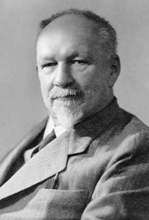Jakob Künzler
Jakob Künzler (March 8, 1871 – January 15, 1949) was a Swiss who resided in an oriental mission in Urfa and who witnessed the Armenian Genocide.[1][2]

Born in Hundwil, Switzerland, he worked in the canton Appenzell and made a living as a carpenter. Afterwards he was trained in Basel as an evangelist deacon (Krankenpfleger). In 1899 he traveled to Urfa in Turkey, where he found his own place to work. He continued to study medicine until he became an independent operating surgeon, and later in 1905 he married Elizabeth Bender, daughter of a Christian missionary and granddaughter of an Ethiopian princess.
From 1915 to 1917 Künzler became an eyewitness to the Armenian Genocide,[3] the subject of his 1921 book In the Land of Blood and Tears. Despite mortal danger he helped provide, when he could, for thousands of Armenian orphans and resumed his hospital enterprise in Urfa.
He was a Swiss pharmacist who had remained in Turkey serving the sick and wounded, non-Muslims and Muslims alike, in a hospital in Urfa who documented accounts of massacres of various Armenian labor battalion companies.[4]
In October 1922 he closed his hospital he worked in and moved his family to Ghazir, near Beirut, where later he opened a center for orphans. Later he established a settlement for Armenian widows in Beirut and a lung sanatorium in Azounieh.
Jakob Künzler observed in August 1915:
... two Turkish officials who appeared in Urfa. The rumor was that they hurried out in order to drive forward the extermination of the Armenian people with all their might, and they had the sanction of the highest state authority for doing so. They ordered on this basis, scarcely the moment they arrived in Urfa, the killing of all gathered prisoners. 'Why should we feed them any longer?' they said.[5]
He died in Ghazir, Lebanon. He was buried in the French Protestant Cemetery of Beirut in which still lies his graveyard.
Prizes and honors
- 1947 award by the University of Basel
- 1959 memorial in Hundwil
- 1971 earnings/service medals of the Lebanese government
- 1971 memorial in Hundwil and Walzenhausen, Switzerland (1971).
Literature
- 1929: In the Land of Blood and Tears
- 1959: Jakob, the Resource in the Service of Life
References
- Turkish Atrocities: Statements of American Missionaries on the Destruction of Christian ... - Page 109
- The Treatment of Armenians in the Ottoman Empire, 1915-1916: Documents Presented to Viscount ... - Page 538 by Arnold Joseph Toynbee
- International Affirmations of the Armenian Genocide – from International Organisations, p.7
- America and the Armenian Genocide of 1915 - Page 66 by Jay Murray Winter
- Jako Kunzler, Dreissig, Jahre Dienst am Orient, (Basel: Emil Birkhauser and Cie, 1933), p.53
External links
| Wikimedia Commons has media related to Jakob Künzler. |
- Jakob Künzler in German, French and Italian in the online Historical Dictionary of Switzerland.